Garden
By COGwriter
The People's Republic of China is the most populous nation in the world. Lands such as Taiwan, Hong Kong, Macao, and Singapore are mainly Chinese, with lands such as Malaysia and Indonesia containing substantial populations of people who are ethnically Chinese. Additionally, there are people of Chinese ancestry scattered in probably most of the nations of the world.
Where did the Chinese people come from? Does the Bible give any mention of those who are Chinese or what might affect many of the Chinese in the future? Does Chinese history in any way support the early Biblical narratives? Was there ever any Church of God influence in China itself?
This series of articles will attempt to provide some answers to these questions.
A related sermon is also available: China’s biblical past and prophetic actions.
The Bible teaches that all peoples descended from Adam and Eve:
20 And Adam called his wife's name Eve, because she was the mother of all living (Genesis 3:20, NKJV throughout unless otherwise noted).
This would include those now considered to be Chinese, as well as all other groups and races of humans.
Noah had three sons. And one of them, Japheth, is believed to be the father of the oriental races, which would include the Chinese. The Bible teaches:
The sons of Japheth were Gomer, Magog, Madai, Javan, Tubal, Meshech, and Tiras. The sons of Gomer were Ashkenaz, Riphath, and Togarmah. The sons of Javan were Elishah, Tarshish, Kittim, and Dodanim. From these the coastland peoples of the Gentiles were separated into their lands, everyone according to his language, according to their families, into their nations (Genesis 10:2-5).
Islamic and other legends teach:
There are numerous Oriental legends about Japheth. According to Mohammedan writers he was the eldest son of Noah, who gave him a stone (called Giude Tasch and Seuk Jede, long preserved in the country of the Mogul), upon which was inscribed the name of God, and which enabled him to cause rain at pleasure. They call him Aboultierk, and ascribe to him eleven sons, among whom are Sin, father of the Chinese, Turk of the Turks, and Ros of the Russians—nations wholly unknown to the ancient Hebrews. They ascribe to his sons great wisdom (Kitto, John; Alexander, William Lindsay. A Cyclopædia of Biblical Literature, 3rd Edition. Black, 1876, p. 465).
According to the Tartars and Orientals, the Chinese are descended from Tchin, or Gin, the son of Japheth (Painter, John Thomas. Ethnology: or The history & genealogy of the human race: Or, The History & Genealogy of the Human Race. Baillière, Tindall & Cox, 1880 Original from Oxford University Digitized Jul 3, 2006, p. 106).
Note: Names sometimes change considerably and hence it is likely that the Islamic writers would have had some names which they believed tied to those listed in Genesis 10, even if they are not similar sounding to the versions that Moses penned in Hebrew. The fact that only one of Japheth son's name (Javan) ended with an "n" hints that he may be the same one that the legends call "Sin" or "Gin" that the Chinese supposedly descended from.
Notice what another researcher wrote:
In China, along the coast, there was a people called Three Han by the early Chinese writers. Han may be a derivative of Javan or Yahan ... The three were Ma-Han, Shon-Han and the Pien-Ha. There is, as Bishop writes, a very close relationship between them and the people who settled Japan. (White C. In Search of ... The Origin of Nations. History Research Projects. 2003, pp. 164-165).
The old Worldwide Church of God pointed to Magog and Javan as the fathers of the Chinese (Stump K. South Asia in Prophecy. Plain Truth, May 1980, p. 9).
The Catholic Encylopedia seems to believe that Magog might be identified with Lydia, but its scholars are unsure where the Chinese came from. Marco Polo identified Muhgu in China with Magog of the Bible (Polo M, Passini L. I viaggi di Marco Polo Veneziano. Translated by Vincenzio Lazari. Tipi di P. Naratovich, 1847. Original from the New York Public Library. Digitized Sep 14, 2007, p. 329), but that does not necessarily make it so.
It seems to be that the Han Chinese derived from Javan and/or a mixture of the sons of Japheth.
Irrespective of which son(s) or grandson(s) of Noah the Chinese peoples descended from, the Bible specifically teaches that all peoples were together and of the same language until after the tower of Babel:
1 Now the whole earth had one language and one speech...
6 And the Lord said, "Indeed the people are one and they all have one language, and this is what they begin to do; now nothing that they propose to do will be withheld from them. 7 Come, let Us go down and there confuse their language, that they may not understand one another's speech." 8 So the Lord scattered them abroad from there over the face of all the earth, and they ceased building the city. 9 Therefore its name is called Babel, because there the Lord confused the language of all the earth; and from there the Lord scattered them abroad over the face of all the earth. (Genesis 11:1,6-9).
Thus, until God confused human language and scattered people abroad, all humans were together and spoke the same language.
If the Bible is true (and I believe that it certainly is) then we would expect that perhaps somewhere the Chinese may have preserved some knowledge of some of the events recorded in the Bible prior to this scattering as well as some connection to the area of Babel.
Could ancient Chinese characters help show the ties that the Chinese peoples have with the Bible?
Yes.
According to legend, Chinese characters were invented by Cangjie, a bureaucrat under the legendary Yellow Emperor. . . The earliest confirmed evidence of the Chinese script yet discovered is the body of inscriptions on oracle bones from the late Shang dynasty (c. 1200–1050 BC). (Chinese characters. Wikipedia. viewed 10/24/14)
Chinese characters are essentially the symbolic representation of words. It is my understanding that both the Chinese and Japanese languages share some of the same characters, and though they pronounce the words differently, thus a few of the characters have the same meaning in Japanese as they do in Chinese. There are over 600 symbols Chinese characters, and although some were changed in the 20th century, most still are essentially the same as they were thousands of years ago.
(Now since I do not read Chinese, or Japanese, I am relying exclusively on the works of others--most heavily from Kees Noorlander from http://www.morgenster.org/signs.htm from which this portion of this paper is indebted to, plus a little bit from Babel Fish by Alta Vista, and quite a bit from http://www.zhongwen.com/ and from the book The Discovery of Genesis).
It should be noted that in the 1950s China nearly decided to abolish characters and even now most Chinese are not taught the history and tradition behind their writing system.
Anyway, since the characters had to start from somewhere (and biblically they would have started sometime after the construction of the tower of Babel), some have suggested that perhaps these characters help demonstrate that the Chinese characters (and Japanese for that matter) demonstrate that they were familiar with some of the events recorded in the first chapters of the Book of Genesis.
For example, the Book of Genesis records:
8 The LORD God planted a garden eastward in Eden...9 The tree of life was also in the midst of the garden...10 Now a river went out of Eden to water the garden, and from there it parted and became four riverheads. (Genesis 2:8,9, 10).
The term English term garden can be represented by the Chinese word tièn (also spelled tián) which is the symbol shown below:
Garden
The Chinese symbol is four irrigation channels within an area of land (it can also mean farm or field). Or it possibly may be the four rivers with a type of tree in the middle of it.
Was that symbol influenced by the events recorded in the Bible or is this a coincidence?
It is difficult to know for certain as there are other Chinese symbols that can be used instead for garden.
However, there are several other characters to explore.
There were two famous trees in the Garden of Eden:
The tree of life was also in the midst of the garden, and the tree of the knowledge of good and evil. (Genesis 2:9).
Recall that God gave Adam one command after placing him in the garden:
15 Then the LORD God took the man and put him in the garden of Eden to tend and keep it. 16 And the LORD God commanded the man, saying, "Of every tree of the garden you may freely eat; 17 but of the tree of the knowledge of good and evil you shall not eat, for in the day that you eat of it you shall surely die." (Genesis 2:15-17).
It is of interest to note that a Chinese symbol for Prohibition is the combination of the symbols for two trees (mù) and command:
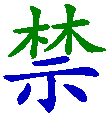 |
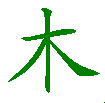 |
 |
To Prohibit |
It should be noted that God, while He originally prohibited one tree, later prohibited access to the second tree (see Genesis 3:22-24).
In Genesis Eve stated:
2 We may eat the fruit of the trees of the garden (Genesis 3:2).
It is also of interest to note that the Chinese symbol for Fruit is the combination of the symbols for tree and garden:
 |
 |
 |
| Fruit | + Garden |
While Adam and Eve were in the garden, the devil decided to implement his plan to alienate humans from God. His plan was to suggest that God withheld secret information for the humans in the garden.
1 Now the serpent was more cunning than any beast of the field which the Lord God had made. And he said to the woman, "Has God indeed said, 'You shall not eat of every tree of the garden'?" 2 And the woman said to the serpent, "We may eat the fruit of the trees of the garden; 3 but of the fruit of the tree which is in the midst of the garden, God has said, 'You shall not eat it, nor shall you touch it, lest you die.'" 4 Then the serpent said to the woman, "You will not surely die. 5 For God knows that in the day you eat of it your eyes will be opened, and you will be like God, knowing good and evil." (Genesis 3:1-5).
Notice that the Chinese symbol for Devil is composed of the characters for secret, person, and garden:
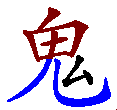 |
 |
 |
 |
Sadly, Eve seemed to believe the devil as she desired to benefit from the fruit of the tree that was prohibited:
6 So when the woman saw that the tree was good for food, that it was pleasant to the eyes, and a tree desirable to make one wise, she took of its fruit and ate (Genesis 3:6).
God decided later to prohibit the second tree lest Eve and others desired it so much that they would go for it as well (see Genesis 3:22-24).
Notice the symbol for the Chinese word lán for desire or greed is a combination of the symbols for woman and two trees:
 |
 |
 |
Greed |
+ Trees |
After succumbing to temptation, humans noticed that they were naked:
7 Then the eyes of both of them were opened, and they knew that they were naked; and they sewed fig leaves together and made themselves coverings. (Genesis 3:7).
Notice that the Chinese symbol for being naked has to do one tree (the one that Adam and Eve were originally told not to eat from perhaps), and a garden with four irrigation canals:
 |
 |
 |
 |
| + Garden |
After Adam and Eve were expelled from the garden they had children. On of their sons was Abel, who raised and sacrificed sheep:
2 Now Abel was a keeper of sheep...4 Abel also brought of the firstborn of his flock and of their fat. And the LORD respected Abel and his offering (Genesis 4:2,4).
Notice what a Chinese character meaning righteous is made of:
 |
 |
 |
 |
| + Hand | + Lance |
Interestingly, the New Testament account of Abel refers to:
35...the blood of righteous Abel (Matthew 23:35).
Notice how the Chinese symbol agrees with the New Testament account that essentially the sacrifice of sheep (by Abel, for example) was righteous.
Since Christ was our Passover lamb sacrificed us, and that through Him we attain righteousness at least one has speculated that perhaps that is why the following symbol for righteousness was somehow chosen (since the combination of the symbol for hand and lance can mean us):
 |
 |
 |
| Righteous(ness) |
And while it is NOT likely that this was determined by the Chinese after Jesus' crucifixion, it is a fact that Abel and Noah, who the Bible calls righteous, sacrificed clean animals such as sheep.
Cain got angry with God and killed his brother Abel. Then God said to Cain:
11 So now you are cursed from the earth, which has opened its mouth to receive your brother's blood from your hand. (Genesis 4:11).
This can be found in the Chinese word xiong for eldest brother:
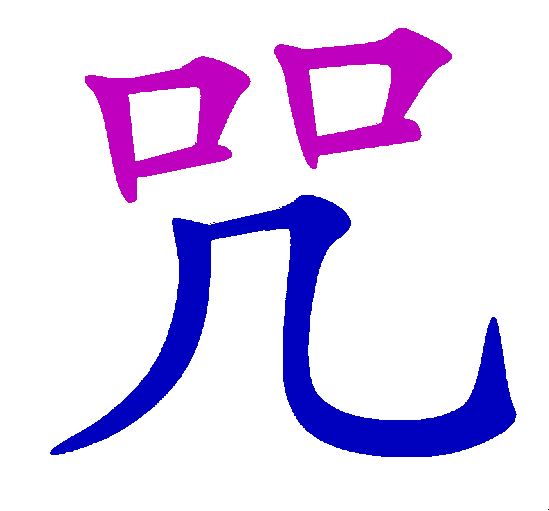 |
 |
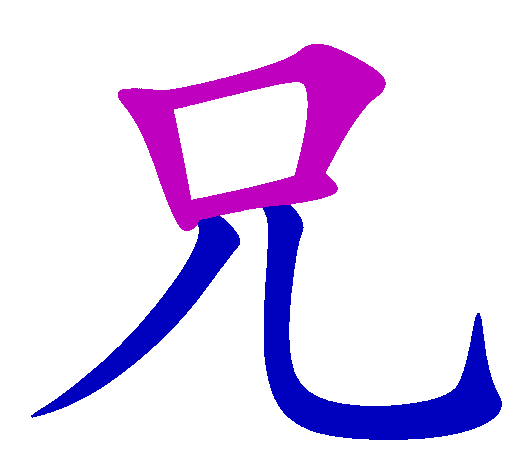 |
||
| Curse | = | Mouth + | Eldest Brother |
Xiong also has other meanings than eldest brother. In that case the pronunciation is the same, but the symbol is different. The other meanings are always negative, like cruel man, killer or drunkard. These meanings are a striking description of Cain.
Note that a mark has been placed on his head:
13 And Cain said to the Lord, "My punishment is greater than I can bear! 14 Surely You have driven me out this day from the face of the ground; I shall be hidden from Your face; I shall be a fugitive and a vagabond on the earth, and it will happen that anyone who finds me will kill me."
15 And the Lord said to him, "Therefore, whoever kills Cain, vengeance shall be taken on him sevenfold." And the Lord set a mark on Cain, lest anyone finding him should kill him. (Genesis 4:13-15).
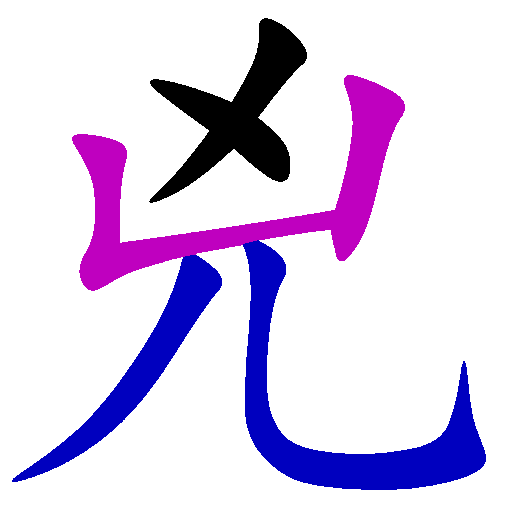 |
| Cruel Man |
| Killer |
So, this is consistent with the 'mark of Cain.'
Many know that Chinese history contains an account of some type of worldwide flood.
There seems to be at least one aspect of the Great Flood preserved in its characters.
Notice a couple of statements in the Bible concerning the flood:
1 Then the LORD said to Noah, "Come into the ark, you and all your household, because I have seen that you are righteous before Me in this generation. (Genesis 7:1).
20...in the days of Noah, while the ark was being prepared, in which a few, that is, eight souls, were saved through water (1 Peter 3:20).
A Chinese word chuán for a type of boat is:
 |
 |
 |
 |
| = 8 | + Little Boat, Vessel |
It may be of interest to note that one of the Chinese symbols for flood (chong) is a combination of an inverted symbol meaning "first Earthly branch" and eight (the term for eight may instead mean "person remaining""--that of itself is interesting as that the symbol for eight and "person remaining" look about the same--recall that on the ark there were only eight persons remaining alive).
After the flood, humans stayed together and built a tower:
1 Now the whole earth had one language and one speech. 2 And it came to pass, as they journeyed from the east, that they found a plain in the land of Shinar, and they dwelt there. 3 Then they said to one another, "Come, let us make bricks and bake them thoroughly." They had brick for stone, and they had asphalt for mortar. 4 And they said, "Come, let us build ourselves a city, and a tower whose top is in the heavens; let us make a name for ourselves, lest we be scattered abroad over the face of the whole earth." (Genesis 11:1-4).
But God did not care for this:
5 But the LORD came down to see the city and the tower which the sons of men had built. 6 And the LORD said, "Indeed the people are one and they all have one language, and this is what they begin to do; now nothing that they propose to do will be withheld from them. 7 Come, let Us go down and there confuse their language, that they may not understand one another's speech." (Genesis 11:5-7).
It is highly likely that when people saw others speaking foreign languages, that they thought that somehow something at this tower affected their mouths. Notice the following Chinese symbol of a tower.
 |
 |
 |
 |
 |
|
| = Grass | + Clay | + Mankind | + Mouth |
The tower of Babel was built with bricks (grass and clay) and humans originally had one language (or mouth). It is possible that this symbol is showing that the ancient Chinese recognized a connection to the biblical tower of Babel.
The Bible shows that after God confused the languages in Babel that He scattered humans all over:
8 So the LORD scattered them abroad from there over the face of all the earth, and they ceased building the city. 9 Therefore its name is called Babel, because there the LORD confused the language of all the earth; and from there the LORD scattered them abroad over the face of all the earth (Genesis 11:8-9).
The Bible also mentions:
25 To Eber were born two sons: the name of one was Peleg, for in his days the earth was divided; and his brother's name was Joktan (Genesis 10:25).
Now whether it was just the scattering of humans that occurred in Peleg's time, or that the earth had continental divisions at that time is not completely clear. What is clear, however, is that humans did separate essentially by language and ethnicity thousands of years ago.
China has long had a legend that it was founded after a great flood. While many dismissed it, there has now been evidence of a major flood in China itself:
August 4, 2016 "The flood is pouring forth destruction. Boundless and overwhelming, it overtops hills and mountains," goes a quote attributed to the legendary Emperor Yao. "Rising and ever rising, it threatens the very heavens."
If civilization was to survive, the people needed a hero who could tame the floodwaters and restore the land. That man was Yu, founder of China's first dynasty, the Xia. Over the course of decades, Yu organized a dredging campaign, dug channels that would carry the water back to its source, and pioneered a tradition of great Chinese public works.
"He brings order out of the chaos and defines the land, separating what would become the center of Chinese civilization," said David Cohen, an anthropologist and early Chinese history expert at National Taiwan University. "He is essentially establishing the political order and the ideologies of rulership."
It is a powerful foundation myth, but many believed that was all it was. Some 4,000 years after the flood was supposed to have happened, historians had found no archaeological evidence of its effect or firsthand accounts of its destruction. There are no historical artifacts from Yu, or the Xia dynasty he founded. All researchers had to go on were stories written long after the fact, dramatized and politicized to justify the ends of those who wrote them.
Until Wu Qinglong, a geologist at Nanjing Normal University, found signs of the flood in the sediments beneath his feet.
In a new paper published Thursday in the journal Science, Wu and his colleagues describe geological evidence for a catastrophic flood on the Yellow River in about 1900 B.C. — right around the time the “Great Flood” was said to have taken place.
"This expands our understanding," said Andrew Sudgen, deputy editor of Science, "not only of civilization’s origins, but also the environment in which ancestral societies emerged." https://www.washingtonpost.com/news/speaking-of-science/wp/2016/08/04/legends-say-china-began-in-a-great-flood-scientists-just-found-evidence-that-the-flood-was-real/?tid=hybrid_experimentrandom_1_na
Now, the biblical flood was probably closer to 2325 B.C. (see Does God Have a 6,000 Year Plan? What Year Does the 6,000 Years End?), but since 1900 B.C. is just an estimate, it could be the biblical flood that Wu Qinglong just found evidence of. On the other hand it is possible that there was a later flood in China. But either way, the Chinese have evidence of a great flood.
While researching this paper I came across a quote that perhaps should be placed here:
...the ancient Chinese people were quite familiar with the same record which the Hebrew Moses is popularly given credit for writing some 700 to 1,000 years later. Imagine this information being stored in special characters that were in use hundreds of years before the first page of the Bible was written! (Kang C.H., Nelson E.R. The Discovery of Genesis: How the Truths of Genesis Were Found Hidden in the Chinese Language. Concordia Publishing House, St. Louis, 1979, p. 5)
Notice that the development of Chinese characters predates the writing of the Book of Genesis. Thus, the Chinese characters seem to provide an 'independent' account that verifies portions of the accounts in Genesis.
Continuing, the authors of the previous citation go so far as to state:
Moreover we believe that the Chinese actually employed this historical knowledge as one small facet in the process of building their written language. The significance of this claim is broad. But most important, it appears to us to give support and added acceptance of the much slandered account of Biblical Genesis (Ibid).
Thus, the existence of these Chinese characters should be a comfort to the Chinese that their ancestors did have some type of biblical witness, as well as the modern believers that even in a land as removed as it is from the Middle East, the Chinese did know about various portions of the Genesis account. And since their characters were developed prior to Moses writing Genesis, their very existence provides additional verification that the events were known for many thousands of years.
In addition to Chinese characters, the following is a prayer believed to be said prior to the acceptance of polytheism in China. This is believed to have been written in the neighborhood of 2230 B.C., about 700 or so years before Moses wrote the Book of Genesis:
Of old in the beginning was the great chaos, without form and dark. The five elements had not begun to revolve, nor the sun and the moon to shine. In the midst thereof there existed neither forms nor sound. Thou, O spiritual sovereign camest forth in Thy presidency, and the first didst divide the grosser parts from the purer. Thou madest heaven; Thou madest earth; Thou madest man. All things with their reproducing power got their being (He Sacrificed to ShangTi as reported in, without its edits, Kang C.H., Nelson E.R. The Discovery of Genesis: How the Truths of Genesis Were Found Hidden in the Chinese Language. Concordia Publishing House, St. Louis, 1979, p. 15).
The above, though not in perfect agreement, is in substantial agreement with the first chapter of the Book of Genesis. This account suggests that at least portions of what God did as also recorded in Genesis were known to ancient peoples, including the Chinese.
It is difficult to be absolutely certain why the Chinese characters described in this paper were developed. However, it seems reasonable to conclude that these symbols do provide evidence that the biblical accounts of the garden of Eden, the flood, and the tower of Babel did involve peoples, like the Chinese, who do not now live in the Middle East.
Hence, it appears likely that even from the beginnings, the ancestors of the modern Chinese did have some basic understandings of God and some of how He had intervened in the affairs of humankind.
Perhaps it should be added that some believe that the Chinese use of dragons is related to time in which they had connection to Babylon
There can be no doubt that the Chinese dragon is the descendant of the early Babylonian monster, and that the inspiration to create it probably reached Shensi during the third millennium B.C. ... at a very early date both India and China were diversely influenced by Babylonia, the great breeding place of dragons ... (Smith GE. Dragons and Rain Gods. As cited in Bulletin of the John Rylands Library, Volume 5. Manchester University Press, 1920. Original from Harvard University. Digitized Jun 5, 2007, pp. 336, 343)Hence, there may be several ways that suggest that the Chinese had ties to the area of Babel thousands of years ago. Just like the Bible says. Hence the early Chinese had some exposure to some of the events as recorded in the Book of Genesis.
Other articles in this series will try to address some of the other witnesses that God has provided to the Chinese peoples, as well as His plan for the Chinese peoples.
A related sermon is also available: China’s biblical past and prophetic actions.
China, Its Biblical Past and Future, Part 2: The Sabbath and Some of God's Witness in ChinaWhen did Christianity first come to China? What about the Apostle Thomas? Did Confucius say anything to get the Chinese to possibly consider Christianity? Is there early evidence that they observed the seventh day sabbath? What about the Ten Commandments? What type of Church of God witness has there been to China? What has been happening with China that ties it together with prophecies in Revelation? What about the 200 million man army and Armageddon? What about the Belt and Road Initiative and end time Babylon the Great?
China, Its Biblical Past and Future, Part 3: China in Prophecy What is Ahead for China? What will happen to nearly all the Chinese?
The Dramatic Story of Chinese Sabbathkeepers This reformattedGood News article from 1955 discusses Sabbath-keeping in China in the 1800s.
Thiel B. Ph.D. China, Its Biblical Past and Future, Part 1: Genesis and Chinese Characters. www.cogwriter.com (c) 2006, 2009, 2010, 2014, 2016, 2017 2019 2025 0326